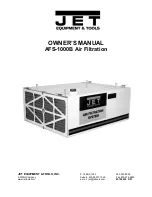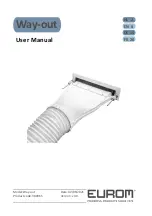
5. TROUBLESHOOTING
This section explains:
What the LED codes mean
What the remote control unit display screen messages mean
How to use the flow charts to find and solve problems
How to use the self-diagnostic tests to find parts that aren’t working right
This unit is made to be trouble free, and not need much service. However, with time, moving parts wear out,
electronic components break down, and sometimes misuse damages the unit.
The purpose of this section is to help you when the unit is not working properly. Sometimes your experience
will tell you right away where to look for a problem, and when you find it you will know how to fix it at once.
Often, however, all you have is a symptom like “poor cooling” or “outside fan doesn’t come on.” Now you must
find out the cause of the problem, and then how to fix it. This section provides several ways to help you go
from the symptom to the cause and then the solution.
The first chart, General Troubleshooting Flow Chart is divided into two sections: Poor heating and Poor
Cooling. Under each heading you will find the main things that can go wrong and cause either of these
problems. Sometimes you can start with this chart and find the problem right away, but often you will come
here for more suggestions after you have looked at the error code on the remote control unit display. This chart
gives you the big picture of problems and solutions.
The other main tool we explain here is the use of the Alarm Messages. When a certain part fails or a safety
device has shut the unit down, any alpha-numeric codes appears on the display to guide you to the problem.
By understanding the code you can often go right to the problem area and then, with this manual and your
knowledge of air conditioning, find the solution.
(1)-1 Check before and after Troubleshooting (GRV250R5)
Many problems may happen because of wiring or power supply problems, so you should check these areas
first. Problems here can cause false results in some of the other tests, and so should be corrected first.
1 . Check power supply wiring
Check the power supply wires are correctly connected between terminal No. 1 & 2 on the 3P terminal plates in
the indoor unit and the outdoor unit.
2 . Check inter-unit wiring
Check that inter-unit control wiring (DC low voltage) is correctly connected between the indoor unit and outdoor
unit.
Power Supply: 50 Hz, single-phase, 220-230-240 V
3 . Check power supply
Check that voltage is within the specified range (±10% of the rating).
Check that power is being supplied.
WARNING
If the following troubleshooting must be done with power being supplied, be careful not to touch any
uninsulated live part that can cause ELECTRIC SHOCK.
4 . Check the lead wires and connectors in indoor and outdoor units.
Check that the sheath of lead wires is not damaged.
Check that the lead wires are firmly connected at the terminal plate.
Check that the wiring is correct.
1
2
U1
U2
1
2
R1
R2
R3
1
2
3
1
2
4
L
N
Indoor Unit
Inter-unit
power wiring
(Line voltage)
Inter-unit
control wiring
(Low voltage)
RED
WHT
BLK
Remote controller
Outdoor Unit
Ground
Ground
D
B
A
0500_M_I
Power supply
R.C. Address on the PCB: 0 (S2, BLK)
(0: Factory shipped state)
220 - 240 V 50 Hz
L
N
0
1
2
3
C
25
















































